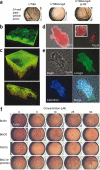Small-molecule inhibitors target Escherichia coli amyloid biogenesis and biofilm formation
- PMID: 19915538
- PMCID: PMC2838449
- DOI: 10.1038/nchembio.242
Small-molecule inhibitors target Escherichia coli amyloid biogenesis and biofilm formation
Abstract
Curli are functional extracellular amyloid fibers produced by uropathogenic Escherichia coli (UPEC) and other Enterobacteriaceae. Ring-fused 2-pyridones, such as FN075 and BibC6, inhibited curli biogenesis in UPEC and prevented the in vitro polymerization of the major curli subunit protein CsgA. The curlicides FN075 and BibC6 share a common chemical lineage with other ring-fused 2-pyridones termed pilicides. Pilicides inhibit the assembly of type 1 pili, which are required for pathogenesis during urinary tract infection. Notably, the curlicides retained pilicide activities and inhibited both curli-dependent and type 1-dependent biofilms. Furthermore, pretreatment of UPEC with FN075 significantly attenuated virulence in a mouse model of urinary tract infection. Curli and type 1 pili exhibited exclusive and independent roles in promoting UPEC biofilms, and curli provided a fitness advantage in vivo. Thus, the ability of FN075 to block the biogenesis of both curli and type 1 pili endows unique anti-biofilm and anti-virulence activities on these compounds.
Figures





Similar articles
-
Discovery of New Genes Involved in Curli Production by a Uropathogenic Escherichia coli Strain from the Highly Virulent O45:K1:H7 Lineage.mBio. 2018 Aug 21;9(4):e01462-18. doi: 10.1128/mBio.01462-18. mBio. 2018. PMID: 30131362 Free PMC article.
-
The UbiI (VisC) Aerobic Ubiquinone Synthase Is Required for Expression of Type 1 Pili, Biofilm Formation, and Pathogenesis in Uropathogenic Escherichia coli.J Bacteriol. 2016 Sep 9;198(19):2662-72. doi: 10.1128/JB.00030-16. Print 2016 Oct 1. J Bacteriol. 2016. PMID: 27161114 Free PMC article.
-
Modulation of curli assembly and pellicle biofilm formation by chemical and protein chaperones.Chem Biol. 2013 Oct 24;20(10):1245-54. doi: 10.1016/j.chembiol.2013.07.017. Epub 2013 Sep 12. Chem Biol. 2013. PMID: 24035282 Free PMC article.
-
Bacterial amyloid formation: structural insights into curli biogensis.Trends Microbiol. 2015 Nov;23(11):693-706. doi: 10.1016/j.tim.2015.07.010. Epub 2015 Oct 1. Trends Microbiol. 2015. PMID: 26439293 Free PMC article. Review.
-
'Omic' Approaches to Study Uropathogenic Escherichia coli Virulence.Trends Microbiol. 2017 Sep;25(9):729-740. doi: 10.1016/j.tim.2017.04.006. Epub 2017 May 24. Trends Microbiol. 2017. PMID: 28550944 Review.
Cited by
-
Experimental manipulation of the microbial functional amyloid called curli.Methods Mol Biol. 2013;966:53-75. doi: 10.1007/978-1-62703-245-2_4. Methods Mol Biol. 2013. PMID: 23299728 Free PMC article.
-
Adhesive fiber stratification in uropathogenic Escherichia coli biofilms unveils oxygen-mediated control of type 1 pili.PLoS Pathog. 2015 Mar 4;11(3):e1004697. doi: 10.1371/journal.ppat.1004697. eCollection 2015 Mar. PLoS Pathog. 2015. PMID: 25738819 Free PMC article.
-
Direct Correlation Between Ligand-Induced α-Synuclein Oligomers and Amyloid-like Fibril Growth.Sci Rep. 2015 May 28;5:10422. doi: 10.1038/srep10422. Sci Rep. 2015. PMID: 26020724 Free PMC article.
-
Impairment of the biomechanical compliance of P pili: a novel means of inhibiting uropathogenic bacterial infections?Eur Biophys J. 2012 Mar;41(3):285-95. doi: 10.1007/s00249-011-0784-2. Epub 2012 Jan 12. Eur Biophys J. 2012. PMID: 22237603 Free PMC article.
-
Transposon mutagenesis identifies uropathogenic Escherichia coli biofilm factors.J Bacteriol. 2012 Nov;194(22):6195-205. doi: 10.1128/JB.01012-12. Epub 2012 Sep 14. J Bacteriol. 2012. PMID: 22984258 Free PMC article.
References
Publication types
MeSH terms
Substances
Associated data
Grants and funding
- R37 AI048689/AI/NIAID NIH HHS/United States
- R01 AI048689/AI/NIAID NIH HHS/United States
- K12HD00850/HD/NICHD NIH HHS/United States
- K08DK074443/DK/NIDDK NIH HHS/United States
- R01 AI049950/AI/NIAID NIH HHS/United States
- AI049950/AI/NIAID NIH HHS/United States
- AI073847/AI/NIAID NIH HHS/United States
- P50 DK064540/DK/NIDDK NIH HHS/United States
- K12 HD000850/HD/NICHD NIH HHS/United States
- R01 AI073847/AI/NIAID NIH HHS/United States
- T32A107172/PHS HHS/United States
- R56 AI073847/AI/NIAID NIH HHS/United States
- AI02549/AI/NIAID NIH HHS/United States
- AI048689/AI/NIAID NIH HHS/United States
- P50 DK64540/DK/NIDDK NIH HHS/United States
- K08 DK074443/DK/NIDDK NIH HHS/United States
LinkOut - more resources
Full Text Sources
Other Literature Sources

